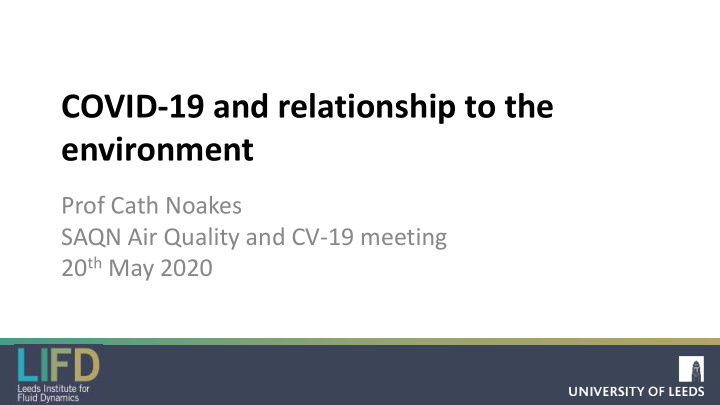



COVID-19 and relationship to the environment Prof Cath Noakes SAQN Air Quality and CV-19 meeting 20 th May 2020
What do we know about SARS-CoV-2? • Small (~100nm) enveloped virus with lipid bilayer • Dispersed through respiratory aerosols + possibly faecal aerosols • Transmission likely dominated by short-range droplet + contact – evidence for close and prolonged contact • Growing evidence for airborne transmission in poorly ventilated spaces • Very little evidence for outdoor transmission
Cough aerosols • Difference between cough particle and virus carrying – not all cough particles will carry virus • Sampling for microorganisms in cough is hard! • May be dependent on viral titre – throat, nose, saliva? This ranges significantly from 600-10^11 per ml • Won’t be naked virus – proteins, surfactants, salts in respiratory droplets – affects the evaporation • Shedding may depend on the individual and stage of infection – likely that more at beginning although faecal later
Dispersion of respiratory aerosols • Ejection rate and direction - Sneeze, cough, sing, talk, breathe all affect the release • Interaction between droplets – cough can be a turbulent “puff” which transports the droplets further • Human thermal plume can influence exhalation flows • Respiratory behaviours – mask, cough into hand • Ventilation/local flow patterns – determine dispersion further from the source • Virus stable in aerosol under room air conditions - over 3 hours shown in laboratory study
Surface contacts • Contaminated through deposition + touching of surfaces • Viral transfer depends on viral load, frequency of touching, type of surface, cleaning frequency • Decay over time – very slow – Studies show 30 min tissue, 4 hours copper, 2 days + on plastic/steel at room temperature – Very stable at 4C – 14 days – Relationship with temperature and humidity https://www.dhs.gov/science-and-technology/sars-calculator • Where are the frequently touched sites?
Controls Focus on three transmission routes: • Contact – Hand hygiene, surface cleaning, no-touch, face touching, anti-microbial surfaces, daylight? • Droplet/short-range – Face covering as source control + some protection, 2m distance, avoid face-to-face, screens, sanitation systems, lose hand dryers • Aerosol – Good ventilation, UV light, ventilation flow patterns, air cleaning devices • All routes – reduce the occupany – reduce viral load in space, reduce chance of coming across an infector • Reduce the time of exposure – shift patterns etc – stay below the dose
Transmission – Research Qs • Dose – how much to get infected? • Prevalence/survival of virus in real environments • Viral shedding from people at different times in their disease • Biological and physics of droplet behaviour • Relative importance of different transmission routes • What is the importance of faecal shedding?
Environments – Research Qs • How do we mitigate in specific environments – Schools, care homes, hospitals, close contact occupations, transport • Synergistic effects of different mitigation measures • How do we adapt buildings to become more resilient? • How do we balance the energy/risk/comfort challenge? • Interaction between engineered environment and human behaviour? • How do we adapt to enable different behaviours but without losing social contexts – lectures, cafeteria? • What to do in winter?
Things to consider in research • Big interdisciplinary questions that need to engage with users/policy • For the rapid call there is a Q on whether the research will have an impact on public health in 12 months • Need to show how the work will have impact
Recommend
More recommend